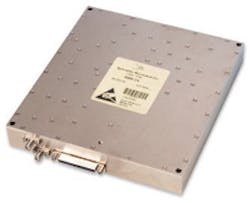Direct-analog frequency synthesizers are known for their fast tuning speeds. Unfortunately, they are also typically known for their large package sizes. Breaking with tradition, however, is the SMS-DA direct analog synthesizer from Spinnaker Microwave, which employs a unique architecture that includes a direct-digital synthesizer (DDS) to enable phase-coherent generation of output signals over selected frequency ranges. The SMS-DA covers a total tuning range of 1.25 to 18.0 GHz in 1-Hz frequency steps, with better than 350-ns tuning speed to switch from any one frequency to any second frequency. This makes it an ideal solution for a wide range of applications, including radar, electronic-warfare (EW) systems, and in test systems.
The SMS-DA direct analog frequency synthesizer (see figure) fits into a light-weight aluminum housing measuring a mere 6.5 x 6.0 x 1.0 in. The rugged housing helps to minimize susceptibility to electromagnetic interference (EMI). A novel synthesizer architecture resides within the compact package, where signals from an external reference oscillator are amplified and multiplied to feed the internal DDS. The DDS generates 200 MHz of baseband bandwidth, which is then fed to a broadband microwave mixer as the RF inputs to the mixer. The local oscillator (LO) signals for the mixer are derived from the same reference frequency input signals, which are similarly amplified and multiplied, filtered, and amplified before being sent to the mixer's LO port. Switch-selected intermediate-frequency (IF) outputs from the mixer are filtered, amplified, and multiplied to achieve the final frequency range of the SMS-DA. Using semiconductor switches, frequency selection and multiplication are almost instantaneous and, combined with the nanosecond tuning speed of the DDS, result in the 350-ns or better tuning speed of the SMS-DA source. An internal field-programmable gate array (FPGA) provides adequate on-board processing power to simplify programming, performing all the mathematical operations needed to set the frequency of the DDS, update the signal phase, and switch frequency bands
The SMS-DA is designed for use with a 100-MHz external reference oscillator; its frequency accuracy will be determined by the frequency accuracy of that reference source. The external reference should provide from +5 to +10 dBm signal power to the SMS-DA. Following its various multiplication, mixing, and filtering stages, the MSM-DA synthesizer delivers typical output power of +10 dBm with only 3 dB amplitude variation across the full 1.25-to-18.0-GHz bandwidth.
For the SMS-DA direct analog frequency synthesizer, output spurious levels are typically -55 dBc from 5 to 10 GHz, -60 dBc or less at frequencies below 10 GHz, and -50 dBc or less at frequencies above 10 GHz. Harmonic levels are typically -20 dBc. The typical single-sideband (SSB) phase noise measured at 10 GHz is -85 dBc/Hz offset 100 Hz from the carrier, -105 dBc/Hz offset 1 kHz from the carrier, -110 dBc/Hz offset 10 kHz from the carrier, -115 dBc/Hz offset 100 kHz from the carrier, and -125 dBc/Hz offset 1 MHz from the carrier.
The SMS-DA direct analog frequency synthesizer accepts reference-frequency input signals and supplies output signals on separate female SMA connectors. It uses a Micro-D 51-pin connector for programming and control, operating by means of low-voltage, transistor-transistor-logic (LVTTL) programming using parallel-port control with lock-detect functionality; binary-coded-decimal (BCD) and user-defined programming formats are also available as options. The frequency synthesizer requires power supplies of +5 VDC and 2500 mA, +15 VDC and 259 mA, and -5 VDC and 800 mA. Additional options are available, including operation to 40 GHz. Standard units are rated for operating temperatures from -10 to +70C; the SMS-DA can also be supplied for an operating temperature range of -40 to +85C.
Spinnaker Microwave, Inc.
3281 Kifer Rd.
Santa Clara, CA 95051
(408) 732-9828
About the Author
Jack Browne
Technical Contributor
Jack Browne, Technical Contributor, has worked in technical publishing for over 30 years. He managed the content and production of three technical journals while at the American Institute of Physics, including Medical Physics and the Journal of Vacuum Science & Technology. He has been a Publisher and Editor for Penton Media, started the firm’s Wireless Symposium & Exhibition trade show in 1993, and currently serves as Technical Contributor for that company's Microwaves & RF magazine. Browne, who holds a BS in Mathematics from City College of New York and BA degrees in English and Philosophy from Fordham University, is a member of the IEEE.
